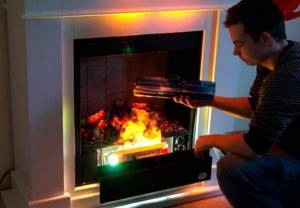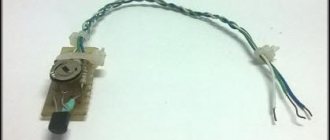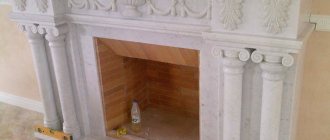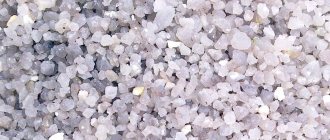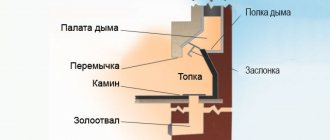There is hardly an owner who would not be tempted by the idea of installing a real classic fireplace in his home. However, on the way to the goal there are often obstacles, one of them is an apartment located in a multi-storey building, where installing the device is either incredibly difficult or completely impossible. There is a solution, and it is quite logical: if there is a desire, but there is no opportunity to admire the open fire, then an electric “colleague” will serve as a replacement for the device. Buying a device is not a very tempting option, as the prices are steep. Therefore, a do-it-yourself electric fireplace is an easier way to accomplish your plans without breaking your wallet.
Devices, operating principle, advantages
An electric fireplace, also called a false fireplace, successfully imitates a real device. It consists of two parts.
- A portal is a frame covered with some sheet material. This design is hollow inside.
- A fireplace that imitates the firebox of the original appliance. Depending on the model, it can perform different functions: serve only as decoration or, in addition, generate heat.
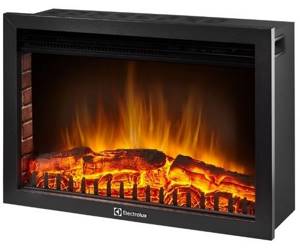
Before you build an electric fireplace with your own hands, you need to study the manufacturers’ technologies in order to choose the model you like for your home. At home, you can make several types of pseudo-hearths, where the imitation of burning wood varies.
- The role of fire is given to red silk. Strips of material are attached to the bottom of the “firebox”, and a fan is installed there, which is lifted by the fabric.
- The effect of fire is created by reflectors installed under “burning” wood from different sides. As they rotate, they project glare that imitates real, living fire.
- Water vapor in “commonwealth” with LED lamps also helps to achieve a natural-looking fireplace.
In models designed to serve not only as a decorative element of the interior, tubular electric heaters (TEHs) are installed in the lower part of the hearth. Heat moves into the room thanks to the operation of fans. They also prevent potential overheating of the case.
It is quite possible to build any of these types with your own hands. Their advantages are undeniable:
- Efficiency equal to 100%;
- complete absence of noise;
- uniform heat distribution;
- minimal energy consumption;
- no need to install a chimney.
Only those electric fireplaces that have heating elements have a slight drawback. This is a large consumption of oxygen during high heat. This disadvantage is easily eliminated by installing effective natural ventilation.
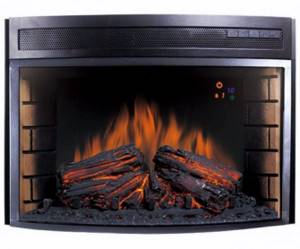
If austerity is not at the forefront, then it is better to purchase an electric fireplace in a store. In this case, the created fireplace will look no worse than a purchased heating device. If you come up with an interesting portal design, you can be sure that no one will have a second such design.
Decorating an electric fireplace
There's plenty of room to expand here! It all depends only on the wildness of your imagination, the flight of which can only be stopped by a lack of necessary materials. To simulate fire, we will need “logs”, lighting and something very similar to live fire.
Logs can be made from ordinary cardboard, rolled into rolls and secured with tape, then wrapped in paper and painted in the desired colors. Also, nothing prevents you from using real dry logs for this, if you have somewhere to get them.
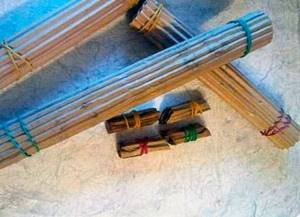
To illuminate the “flame,” it is best to use LED bulbs that shimmer in red and yellow colors. They can be placed behind a flame or ember decoration made from sheer fabric or other material.

Here is a step-by-step process for making the simplest flame decoration in the hearth:
- We take the most ordinary tree branches of medium thickness (8-10 mm).
- We wrap them in foil, onto which we glue strips of tulle or lace on top.
- After the glue has dried, the branches are pulled out of the foil (if they are not pulled out, you can cut the foil lengthwise, and then glue the lace back into tubes).
- Place pebbles on the bottom of the fireplace in a semicircle.
- Place a rolled up garland in the center of the circle of stones.
- Place logs of lace above the “hut” garland and fasten them at the top with leftover fabric or threads.
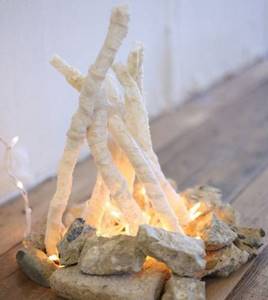
To achieve the best effect, you need a garland that alternately flashes yellow and red. But even an ordinary light bulb that burns only yellow will do.
For more advanced flame simulations, various tricks are used: mirrors, rotating light sources behind a panel depicting fire, or transparent fabric that can be rigidly fixed to a frame, or cut into flaps and a fan installed under them, the flow of air from which will make them “dance.”
Portal, materials for it
When building a real fireplace, serious demands are placed on the frame, since it must serve as reliable protection for the adjacent wall from exposure to high temperatures. The beauty of an electrical device is that it must perform only a purely aesthetic function - have complete resemblance to the real design. Authenticity will be ensured by cladding imitating brickwork, marble finishing or façade design with wild stone.
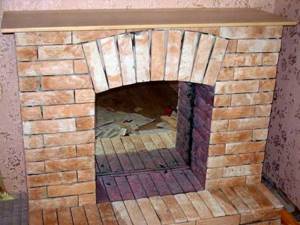
Requirements for electric fireplaces
The stability of the structure is also necessary, since in addition to the electric hearth itself, the tabletop on which various decorative items are placed is also taken into account for reliability. If you plan to place some equipment on the fireplace, then make the shelf wider. To provide stability, in some cases it is advisable to secure it additionally - using a corner screwed to the wall. This measure applies only to stationary models. There are also mobile portals for the fireplace, which are small in height but sufficiently wide, ensuring that there is no threat to the owners, because the narrow structure is not immune to falls.
Materials for false fireplaces
If classic appliances are traditionally faced with stone - natural or artificial, then these materials are not very suitable for independent construction, since without the skills the master will have great difficulties. Their adequate replacement for a tabletop would be a thick wooden board, treated with stain and coated with several layers of varnish. Other “surrogates” are plywood or MDF. In this case, the surface is camouflaged with small ceramic tiles or laminated with decorative film.
The material for the frame is chosen depending on the functions of the electric fireplace. If it plays only the role of decoration, then there are no special restrictions. The list of potential candidates includes:
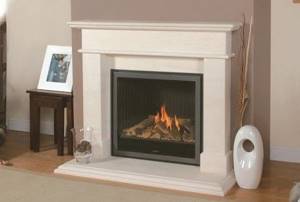
- Drywall. This material is readily used for almost all interior decor elements. The main disadvantage - low load-bearing capacity - is mitigated by a reliable frame made of metal profiles.
- Tree. This building material is always among the favorites because of its environmental friendliness and ease of work, which is still relative. For example, carving and milling are not available to every craftsman. The big disadvantages are fear of moisture, potential deformation, so it is better to choose species that do not have the last drawback - cedar, aspen, pine.
- Chipboard, MDF. These materials are also suitable candidates for a fireplace portal, because their disadvantages are relative. The toxicity of resins in the boards is eliminated by finishing with an airtight material. Loose fibers remaining on the cut, complicating the covering, are a nuisance that only beginners encounter.
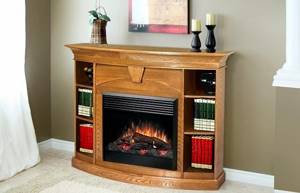
When the equipment also plans to fulfill its intended purpose, then safe materials are required - ordinary or fire-resistant plasterboard, foam blocks. However, there is another option: heat-resistant types of finishing - plaster, mineral tiles, tiles - will help protect the device from high temperatures.
Security measures
Despite the fact that the future fireplace is considered safe, additional measures must be taken. If the hearth has a heating function, then it is possible that the wall to which the portal is adjacent may heat up. It is recommended to cover its surface with a heat-resistant substance. Asbestos sheets can be used.
The absence of a live flame does not mean a lack of ventilation. When making the frame, and subsequently when covering it, it is necessary to provide for the presence of ventilation holes. They will not allow warm air to accumulate and will protect the fireplace from overheating.
If it is not possible to install the fireplace directly near an electrical outlet, you will have to lay an additional power cable. While the profile has not yet been sheathed, it’s time to think about it.
Good to know: Electric fireplaces with the effect of live fire, simple classification into types
The cable should be selected based on the power of the heating element. Offhand, the cross-sectional area should be at least 2.5 mm2. For complete safety, it would be a good idea to hide the cable in a corrugation or cable duct.
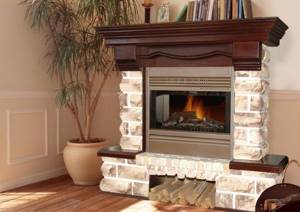
Such devices are considered economical, even if there is a heater functionality
Portal, its form, style and place
The project creation stage begins after purchasing an electric fireplace insert. They focus on its size when making a drawing. Nowadays, furnace “semi-finished products” are popular, which do not have additional decor, which makes it easier for owners to choose the design of a new piece of furniture. If, nevertheless, pronounced “embellishments” are present, then they should serve as the main guideline.
The main options for decorative finishing and portals for the fireplace:
- The small size and simple shape of the frame, decorated with painted glass or metal, are ideal for rooms designed in modern styles that do not tolerate pretentiousness and huge dimensions.
- The design, finished in marble or with plaster stucco, and columns (or imitation) arranged symmetrically, will appeal to lovers of the classics. In addition to gypsum, polyurethane is used for finishing.
- Portals made of expensive wood, decorated with carvings, monograms and gilding, are chosen by admirers of the Victorian style. In this case, the finishing with dark tiles imitating polished stone is especially interesting.
- The oversized structure made of light lacquered wood will look great in small rooms decorated in a country style. For larger rooms, finishing with decorative bricks is suitable. Another option is plaster adjacent to artificial stone.
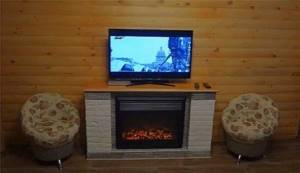
Dimensions and shape must match the room. A bulky design will look awkward in a tiny room. The standard remains the rectangular shape, the originals are angular designs. Since the fireplace is an interior detail that always attracts attention, the wall adjacent to it should not have unnecessary decor.
A pedestal is the only thing that should be a part of any fireplace. It is not necessary to maintain its dimensions, since the owners are their own masters. As for the recommendations, they are as follows:
- the width of the pedestal is made 300 mm larger than that of the fireplace;
- typical height is up to 200 mm.
Stage 1. Selecting a location for installation
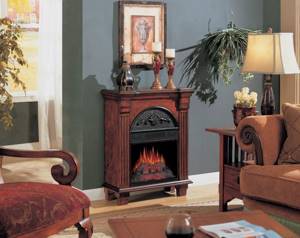
Everything here is quite simple: any wall you like will do, preferably in the living room.
Note! You should not plan to build a large structure in a small apartment. The fireplace must fit the area.
Plasterboard portal with metal frame
This design is optimal due to the fact that both materials allow you to create a fireplace of any complexity, as well as ensure its reliability. However, this device can only be stationary, non-transportable. Moving a drywall structure is not a good idea for a rather fragile material.
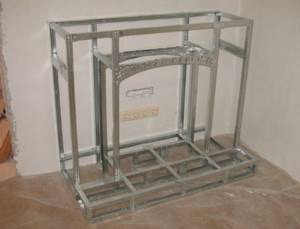
Materials, tools
The type of plasterboard board is selected depending on the planned cladding. If its role is played by tiles, then only a green, waterproof type of gypsum board is needed. The best material for the frame is galvanized profile. If we talk about fasteners, then to assemble the frame you will need metal screws - “bugs” (11-13 mm). For cladding - hardened (black, 3.5-25 mm).
The rest of the list depends only on the features of the cladding.
To decorate with plaster you will need to purchase:
- reinforcing tape;
- primer for drywall;
- plaster;
- interior paint.
If tiles are your favorite, you will need:
- tile;
- primer;
- tile adhesive or liquid nails;
- grout for seams.
Any of the following materials are suitable for the manufacture of countertops:
- edged board;
- MDF with plastic coating - imitation wood;
- plywood.
For the ends of the tabletop, you need to buy furniture edges.
Tools you will need:
- grinder and thin cutting disc, alternative - metal scissors;
- screwdriver;
- level;
- marker.
Drawing, calculation of materials

A sketch with dimensions indicated allows you to pre-calculate everything you need:
- Drywall. Sum up all surface areas excluding the back wall. The optimal material thickness for a fireplace is 12.5 mm, if there are radius elements - 9.5. The sheet standard (1200x2500 mm) makes it possible to create a cutting diagram in advance.
- Profile. The number of racks and horizontal jumpers depends on the dimensions of the device. For guides, buy a PP profile (27x28 mm), for racks and reinforcements - PS (27x60 mm).
Main job
Based on the drawing, make markings (marker, chalk, pencil) on the wall and floor. In accordance with the dimensions, metal parts for the “frame” are cut out.
Frame
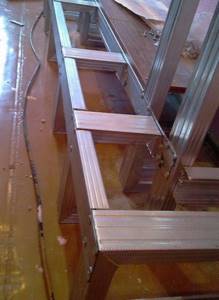
- The PP floor guide elements are laid first, their horizontalness is checked, and the floor guide elements of the PP are secured with dowels and self-tapping screws. The corresponding horizontal sections are fixed on the wall.
- Vertical PS profiles are mounted to the wall, which are fixed to the base strips. Then the top trim is completed. All racks are connected by transverse stiffeners, their maximum pitch is 600 mm. To strengthen the fireplace podium, short racks are installed, the distance between them is 200 mm.
- In the plane where the electric firebox will be located, a horizontal piping is made. Then the supports are fixed to frame the hearth. The last belt, which does not carry any load, is mounted above the electric firebox.
If radius elements are provided, the metal profile is cut in increments of 50-80 mm and then carefully bent, obtaining an ideal arc.
Plasterboard works
The assembled frame is measured several times. All numbers are transferred to sheets of material, and patterns of all elements are made.

- The blanks are cut out with a mounting knife with a new blade. They are fastened with self-tapping screws, recessing the caps shallowly (1-2 mm).
- All corners are taped with sickle tape. Another option is to strengthen them with perforated galvanized corners.
- Joints and holes from self-tapping screws are puttied. The surface is primed and again, this time completely, puttied. A final coat of primer is required.
- They try on the firebox. Holes are cut opposite the ventilation eyes. The same operation is repeated in the future - while working with the finishing material.
- After cladding, a tabletop is laid on top and an electric hearth is inserted.
Stage 6. Wiring communications
The next step in creating an electric fireplace is wiring the cables to the location of the structure. It is recommended to use cables with “self-extinguishing” insulation with a cross-section of 2.5x2 for this purpose. In the portal itself, the cable is laid in a metal “sleeve”.
Note! If there is grounding in the apartment, a three-core cable should be used. Then the fireplace will need a ceramic socket with grounding.
When installing an outlet, it is advisable to also connect a switch - in this case, you will not have to remove it every time you need to turn off the device. In other words, you can turn it on/off using a switch.
Fireplace with a portal made of plywood and wood
The advantage of this method is the massiveness of the structure, which allows you to place even quite heavy objects on the tabletop. However, in this case it is necessary to take into account the thickness of the wooden elements.
Tools, materials
To build a wooden-plywood fireplace portal you need to have on hand:
- timber for the frame (50x50 mm);
- plywood (minimum 12 mm);
- screws for wood, dowels;
- drill;
- perforator;
- screwdriver;
- jigsaw;
- deep penetration antiseptic;
- primer;
- putty;
- stain or paint, but only its heat-resistant type;
- varnish
If an overlay decor is chosen for finishing, then wood glue is added to this set.
Stage 2. Buying an electric fireplace
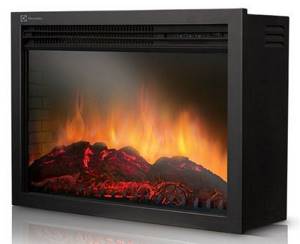
Electric fireplace ELECTROLUX EFP/P-3020
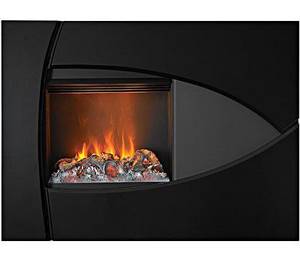
Having decided on a place, you can go to the store to buy a firebox. Such devices cost an average of 25-30 thousand rubles, but you should focus not only on the price, but also on the size of a particular model.
In an apartment where literally every centimeter of free space is valuable, it is better to install oversized and shallow fireplaces. The most compact models have a depth of 7 cm. Among the manufacturers, it is worth highlighting the German company Hark, the British Burley and the Irish Berry.
Video - Electric fireplaces for apartments
Find out how to make a false fireplace with your own hands with step-by-step installation and finishing instructions from our new article.
Imitation of fire in a fireplace: how to do it yourself?
The installation of a fireplace is one of the interesting interior solutions that gives the interior of a home internal warmth, comfort and homely appeal.
But it is not always possible to fit a real fireplace into the design. As a rule, this is due to the inability to install a chimney, lack of space to store firewood and other reasons related to the use of an open fire indoors. There is nothing difficult to create an imitation of a fireplace without heating in an apartment with your own hands. This will require sheets of drywall, materials for exterior finishing, imagination for the project and a good mood for work. The false fireplace is ready and all that remains is to fill it with artificial flames, sit in a chair and enjoy the play of light and shadow.
The main task of the illusion of a living fire in the hearth is to create a spectacular, most realistic feeling of a burning flame. Visualization is the main element of the task, but it is far from the only one. To complete the perception of the picture, not only the visual component is necessary, but also the corresponding crackling sound and smell of burning panels, as well as the physical sensation of heat flow. To do this, there are modern techniques for creating a “cold fire” in a false fireplace.
How to decorate - making decorative firewood

Cardboard is rolled into tubes
Creating a dummy firewood yourself is not a difficult task.

Elements are connected to each other
They can be made from materials that everyone has on hand. As an example, we will look at firewood that is made from cardboard, glue, tape and paint.

Imitated logs need to be painted
Of course, decorative firewood can also be purchased ready-made. They just aren't cheap.
First, cut out a cardboard blank for firewood. Then glue this blank so that it resembles a log. Paint the resulting firewood and place it in the fireplace.
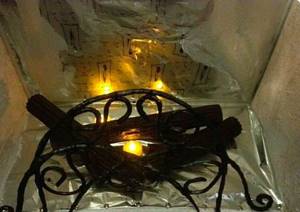
Decorative cardboard logs placed in a simulated hearth - cheap and cheerful
Stage 7. Sheathing with plasterboard
After wiring the cable, it is necessary to cover the frame with plasterboard.
Step 1. Using a stationery knife, cut out sheets of material of appropriate sizes.
Step 2. The sheets are attached to the profile using a screwdriver. For this, “seed” screws (black, intended for metal) measuring 2.5 x 0.3 cm are used.
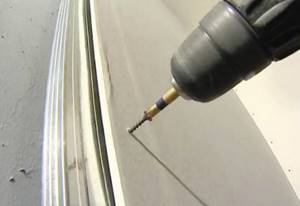
Fastening drywall sheets
Step 3. The joints between the sheets of drywall are puttied with sealant.
Step 4. This material itself is quite fragile, so all corners of the electric fireplace are reinforced with galvanized steel corners (necessarily perforated).
Step 5. All surfaces are primed and puttied.
Step 6. Preliminary fitting of the electric furnace in the finished frame is carried out. Opposite the ventilation lugs located in the device body, holes are made in the drywall. If this is not done, the firebox will overheat during operation.
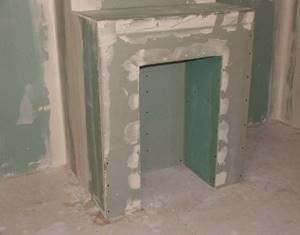
Puttying plasterboard sheets
Where is the best place to install the fireplace?
Before starting work, you need to decide on the type of structure. She may be:
- Stationary. A frame made of wooden blocks or metal profiles is attached to the wall. This allows you to make narrow and tall elements. They take up minimal space, but the process of moving products to a new location is very labor-intensive.
- Attached. Requires a broader, fundamental basis. At the same time, he can move freely to any point in the apartment. And if necessary, it can easily be transported to another house.
The location of the portal for a decorative fireplace is chosen based on aesthetic preferences and practical benefits.
On a free wall. An improvised hearth can serve as an independent decoration. Visually complements the interior if placed under the mirror. The upper part serves as a shelf for hygiene items. Stationary models are used instead of a TV stand.
In the corner. Most often, with this arrangement, heating risers are closed. The structure is made up to the ceiling, and for stability it is permanently attached to the wall
It's easier to decorate it. In this case, the hearth must be attached. To maintain the circulation of warm air, a convection grill is inserted into the improvised firebox or lid.
How to achieve the natural flame effect
Modern electric fireplaces look so perfect that even standing next to them, it is difficult to distinguish them from a real hearth. The effect of realistic flames in such fireplaces is created by the evaporation of water in an ultrasonic steam generator. Therefore, such models do not dry, but, on the contrary, humidify the air. The resulting steam is illuminated with halogen lamps with a special filter. This achieves the effect of flaming flames and billowing smoke. The flame looks so realistic that you involuntarily want to raise your hands to it. Moreover, in some models, access to the fire is not blocked by either a grill or glass, so if you wish, you can touch the flames without fear of getting burned.
Troubleshooting and troubleshooting
All consumers, according to their mentality, are conditionally divided into two categories:
- The first believe that everyone should take care of their responsibilities. If there is a service for repairing household appliances, then specialists should diagnose and repair fireplace malfunctions.
- The latter believe that any device was created by a person, which means that anyone can repair it.
Experienced craftsmen who have repaired electric fireplaces more than once advise sticking to the “golden mean”, since, despite the apparent complexity, the operating principle of the heater is quite simple. But at the same time, modern technologies make it possible to install some components in such a way that they become irreparable and must be replaced as entire units.
The algorithm of action in case of breakdown of electric fireplaces is simple and standard: determine the source, determine the degree of its maintainability, repair (replace). It’s worth mentioning right away that there are very serious breakdowns (display, ultrasonic generator, control chip), which will have to be addressed to a specialized company. But according to statistics, most faults can be corrected independently.
